“Past Tense, Part I”
Written by Ira Steven Behr & Robert Hewitt Wolfe
Directed by Reza Badiyi
Season 3, Episode 11
Production episode 40512-457
Original air date: January 2, 1995
Stardate: 48481.2
Station log: The Defiant flies the senior staff to Earth to address Starfleet on the Gamma Quadrant situation. Sisko, Dax, and Bashir beam down to a dinner with a particularly dull admiral (“Droner” Drazman, as he’s known), but something happens to the annular confinement beam when O’Brien beams them off.
Sisko and Bashir wake up on a San Francisco street in 2024. Their rank insignia and combadges are gone, and two cops, Vin and Bernardo, pick them up and take them in, calling them “dims,” given their state of dress (“matching pajamas”), lack of ID, and querying what year it is.
Dax is nearby, at the bottom of a subway staircase. By virtue of not being in the open, her combadge and insignia are in place and not stolen. A man named Chris Brynner sees her and assumes she’s been robbed—they got everything but her “brooch” (the combadge). Brynner offers to let her use the interface terminal in his nearby office to order new ID.
Back on the Defiant, the logs show that the trio did materialize on the other side, but there’s no sign of them on Earth. From Starfleet HQ’s perspective, the beam disintegrated partway. The ACB spike came from a chroniton particle surge from the cloaking device. O’Brien has no idea why that had the effect it did, but he eventually learns that a microscopic singularity exploded, exciting the chronitons lodged in the ablative armor and causing the transporter to send them back in time.
In 2024, Bashir and Sisko are put in a Sanctuary District, where homeless people are placed. It’s a run-down dump with people living in ramshackle tents and burned-out buildings. Bashir is, to say the least, appalled, assuming that these are criminals to be treated so poorly. Vin (having let his partner go home to see his wife) processes them, only to discover their fingerprints aren’t on file. So in the tried and true tradition of bureaucrats the world over, he hands them a form to fill out. While they’re waiting to be processed, Bashir bitches about how many of these people need proper medical treatment, but Sisko has bigger concerns when he sees the date and realizes which Sanctuary District they’re in. The Bell Riots—a brutal civil uprising in which hundreds of Sanctuary residents are killed—was a bellwether event for the 21st century. One of the reasons the riots were so important were the heroic actions of a Sanctuary occupant named Gabriel Bell. And the riots are going to happen in this Sanctuary District in a few days.
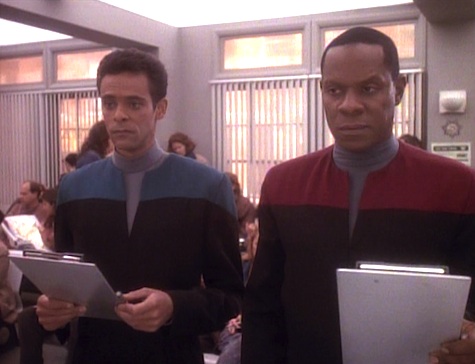
Dax is doing much better. She’s used her mad 24th-century computing skillz to fashion an ID for herself. Brynner reveals himself to be the head of Brynner Information Systems. Dax plays him like a two-dollar banjo (cleverly identifying her Trill spots as tattoos).
Sisko and Bashir are revealed to be “gimmes” (people who are looking for work), not to be confused with “dims” (what Vin thought they were, the mentally ill who are dumped on the Sanctuary Districts for lack of anywhere better to put them) and “ghosts” (who “haven’t integrated well” with the Sanctuary). They’re given ration cards that will allow them to get food and water and sent on their way. Finding a place to sleep proves harder, as each building they come to is filled up. They pass a mugging: a bunch of ghosts, led by a man named B.C., beating someone up. Sisko has to physically restrain Bashir from interfering.
Brynner gets Dax a hotel room for a few days while she looks for her friends. He also invites her to a get-together in his office the following day—he wants to know how it turns out.
On the Defiant, O’Brien narrows it down to a few dozen possible timeframes they could have beamed to. The problem is, while they can re-create the transporter conditions that created the problem, they only have enough chronitons to do it five or six times.
Sisko and Bashir spend the night in an alley. Bashir awakens to swear he’ll never complain about DS9’s Cardassian beds again. They trade their uniforms (which are funny-looking but at least they’re warm) for less warm but also less conspicuous clothes and access to the roof of one of the buildings. They come across a man named Webb caring for his son, who was beaten up by ghosts. Webb’s wife went to get help, but there’s only one doctor on duty. Bashir does a quick exam to learn that he’s just cut and bruised, no broken bones. Webb tries to recruit them for his attempt to organize the people in the district, to let the people outside the Sanctuaries know what’s going on in there but, mindful of the possibility of polluting the timelines, they decline to get involved, preferring to be left alone.
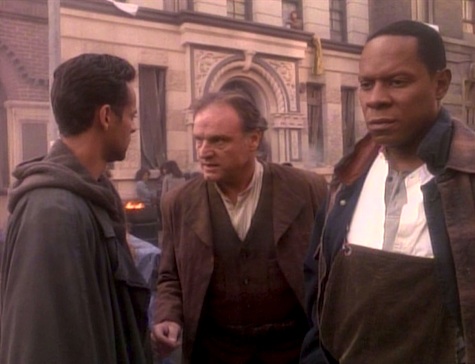
Dax mingles at Brynner’s party, and after telling her story of being “mugged,” she finds out about the Sanctuary Districts, and asks for Brynner’s help to see if Sisko and Bashir were sent there.
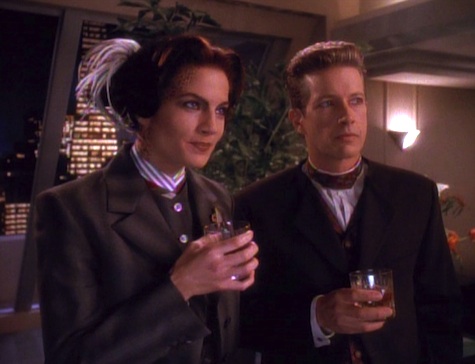
While waiting on the food line, B.C. comes back to attack Bashir and Sisko. In the ensuing fight, a man helps them out, only to get stabbed and killed by B.C. The man who saved their lives at the cost of his own was Gabriel Bell.
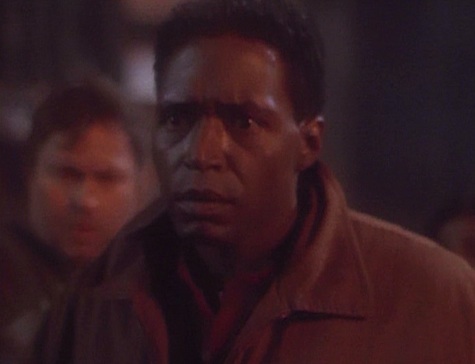
This has an immediate effect on the timelines, as the Defiant finds that all hint of Starfleet presence is gone from the entire Earth star system. The ship itself was unaffected thanks to the chronitons, but the nearest subspace signal O’Brien can find is in Alpha Centauri, and it’s Romulan. But Bell’s death has changed history, causing the Federation to never have happened—or if it did, Earth was not part of it.
Sisko and Bashir decide to join up with Webb’s protest. There’s going to be a rally outside the processing center to remind folks that they agreed to live in the Sanctuary District because they were promised a job, but Webb hasn’t been on any job interviews lately, and neither has anyone else. They’ve been forgotten, and Webb wants to remind them that they’re there. Webb wants Sisko and Bashir to help spread the word, and to tell people to bring their families and to dress as nice as they can.
A fight breaks out between Bernardo and some dims. Sisko and Bashir break it up, with Sisko getting his hands on Bernardo’s rifle. The attack on Bernardo turns out to have been a distraction so B.C. can take over the processing center. He takes everyone hostage, and Sisko and Bashir bring Bernardo in to find this, and Sisko quickly joins with B.C.’s endeavor rather than try to start a fight that will get a lot of people hurt.
Sisko identifies himself to B.C. as Gabriel Bell.
To be continued…
Can’t we just reverse the polarity? As established in TNG’s “The Next Phase,” cloaking devices sometimes emit chroniton particles. Apparently, they’re very much like dust mites, as they get caught in the Defiant’s ablative armor matrix. A microscopic singularity explosion gets the chronitons all hot and bothered enough to interfere with the transporter beam and send Sisko, Dax, and Bashir back 347 years.
The Sisko is of Bajor: Sisko is apparently a student of 21st-century history—more than Bashir can say, as he found the era too depressing—which proves handy in knowing what’s about to happen, and why the guy who saved their lives dying is such an issue.
Don’t ask my opinion next time: Kira takes charge of the Defiant in Sisko’s absence, and makes a very valiant effort to keep up with O’Brien’s stream of technobabble. She also takes great joy in bowing out of dinner with the admiral (as do O’Brien and Odo).
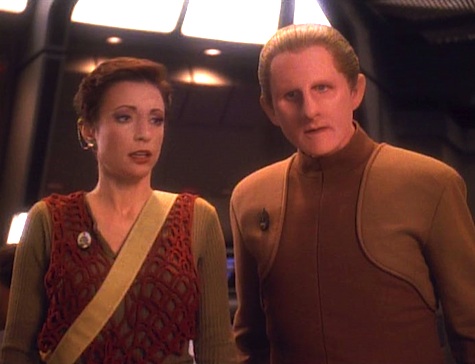
The slug in your belly: Dax’s super science officer-ness comes into play here, as she not only effortlessly creates an identity for herself with a computer interface, (no Montgomery Scott saying “Computer” into a mouse here…), but she also never misses a beat when explaining her situation, unhesitatingly referring to her combadge as a brooch and her spots as tattoos. So often these things are played broadly, in a manner that realistically would raise red flags to the person being spoken to, but instead Dax slides effortlessly into the 21st century, as you would expect a professional science officer (and person with three centuries’ experience) to do.
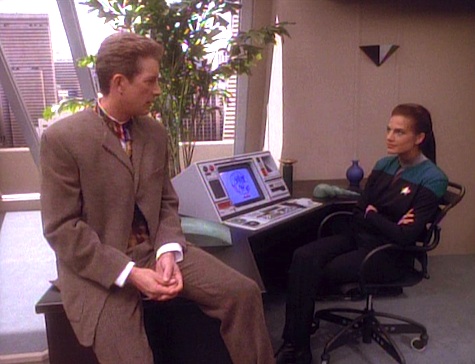
Rules of Acquisition: We get two Rules, quoted by Quark and Sisko to each other: #111 (“Treat people in your debt like family: exploit them”) and #217 (“You can’t free a fish from water”). Sisko tells an impressed Quark that he’s been reading up on the Rules.
No sex, please, we’re Starfleet: It’s pretty obvious that at least part of the reason why Brynner helps Dax is because she’s pretty damn hot.
Tough little ship: This is the first mention of the Defiant’s ablative armor, an additional layer of protection beyond the shields. (And also apparently something that gets chronitons all stuck in it.)
Keep your ears open: “Full dress uniforms, fine table linens, and a different fork for every course—thanks but no thanks. That’s why I stayed an enlisted man. No one expects us to show up for formal dinners.”
O’Brien gleefully turning down the invite to come along to dinner with the admiral.
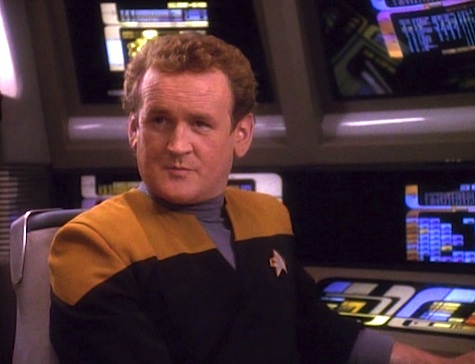
Welcome aboard: Veteran character actor Dick Miller—last seen on Trek as the 1941 holodeck news vendor in TNG’s “The Big Goodbye”—appears as Vin. Frank Military play B.C., Jim Metzler plays Brynner, Al Rodrigo plays Bernardo, and Tina Lifford plays Lee. And our Robert Knepper moment is Bill Smitrovich as Webb. I’d forgotten that the great Smitrovich was in this; to me, he’ll always be the cigar chomping (but never smoking) Inspector Cramer on A&E’s A Nero Wolfe Mystery series. All of the above will be back in Part 2.
The original Gabriel Bell is played by John Lendale Bennett. While Bennett has had a couple of actual roles, most notably as Kozak in “The House of Quark,” he mostly served on the show as Avery Brooks’s stunt double, photo double, and stand-in, which makes his casting as Bell extra entertaining.
Trivial matters: While this episode was being filmed, Los Angeles Mayor Richard Riordan proposed a fenced-in area for the city’s homeless that was eerily similar to the Sanctuary Districts of this two-parter.
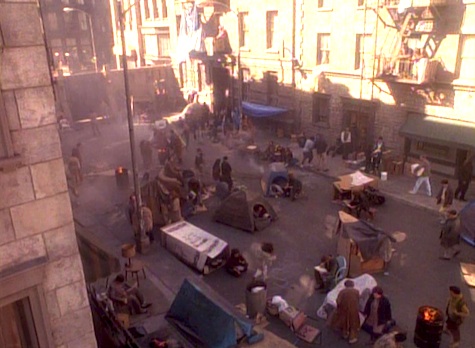
This is the first DS9 episode to show Earth, and the first not to have any scenes at all on Deep Space 9.
Bashir’s question to Sisko about humanity reverting if faced with a real crisis will get a practical answer in the “Homefront”/“Paradise Lost” two-parter next season, in the sixth-season episode “Inquisition,” and the seventh-season “The Siege of AR-558.”
Several of the people in this episode are named after characters in The Magnificent Seven (Chris, Vin, Lee, Calvera), with the name Brynner also coming from Yul Brynner, the lead in that movie. B.C. was named after first assistant director B.C. Cameron.
This is the first mention of Starfleet’s temporal displacement policy, which will be mentioned again in “Trials and Tribble-ations.”
Walk with the Prophets: “Welcome to the 21st century, Doctor.” It was incredibly bizarre to watch this episode realizing that it’s now closer to the “future” date the crew travel back to (eleven years) than it is to when the episode was filmed (nineteen years). This causes some cognitive dissonance, especially with the things that weren’t predicted—styluses rather than touchscreens, the computers, while smaller than those of the mid-90s, aren’t quite small enough, and nobody saw the ubiquity of cell phones coming. (Seriously, every time our heroes were told they had no way of getting in touch with their friends, I kept waiting for someone to be confused as to why they didn’t have their phones with them.)
Still, the details are less important than the message, and much as I’d love to say that the notion of Sanctuary Districts is unrealistic, I can’t do so with a straight face. And it’s depressingly realistic that the pretty woman gets the benefit of the doubt and the two brown-skinned men get tossed in with the homeless people.
And what makes the episode work is that it sells both the beaten-down hopelessness and the fact that this isn’t the result of malice but being overwhelmed. We do have a straight-up bad guy in B.C., but most of what we see are people who are just trying to get through: Webb, who was hoping for a place to stay while he found his way back to his feet, and instead got lost in the shuffle; Vin, a veteran just doing his job who sees Sisko and Bashir’s slog through the bureaucracy as a means to more paid overtime; Bernardo, who just wants to go home after an overnight shift to see his wife; and Lee, who knows the system sucks, wishes the system didn’t suck, but muddles through to do the best she can within the sucky system.
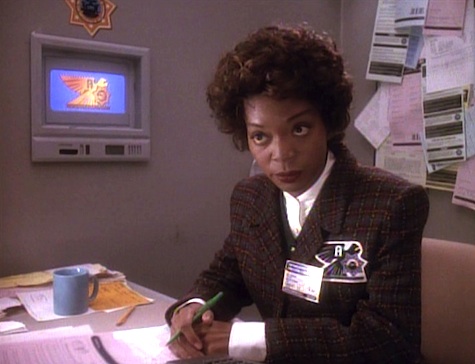
And then there’s Gabriel Bell, whom we first see as one of the dims, writing on pretty much any surface that presents itself except a piece of paper, who later doesn’t even hesitate to put his life on the line to save two guys he’s only met once before. It’s the same instinct that would lead him to become an important historical figure, and one that Sisko gets to try to live up to—but that’s Part 2.
Unfortunately, the episode doesn’t trust itself to create the world of 2024 without hitting us over the head. We get everything we need to know about the setting from Sisko and Bashir’s intake interview with Lee, from Webb’s plaintive call for a rally to remind people they’re alive, and probably most efficiently by a simple dialogue exchange at the high-class party Brynner throws, where one person mentions that Dax might have been sent to a Sanctuary District and his companion blithely asks, “Do they still have those?” But rather than trust the dialogue and the situations to spell it out, they hit us over the head with two really overlong expository conversations between Sisko and Bashir as they walk through the Sanctuary.
Structurally, this two-parter is very much like “The City on the Edge of Forever,” and it would seem to be ballsy to try to redo one of the two or three best Star Trek episodes ever done. But it’s still a strong story with a strong—and still depressingly relevant—message.
Warp factor rating: 7
Keith R.A. DeCandido has autographed copies of many of the books and comics he’s written for sale. Information, including several new books dug up in the garage recently, can be found here.










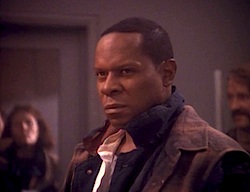

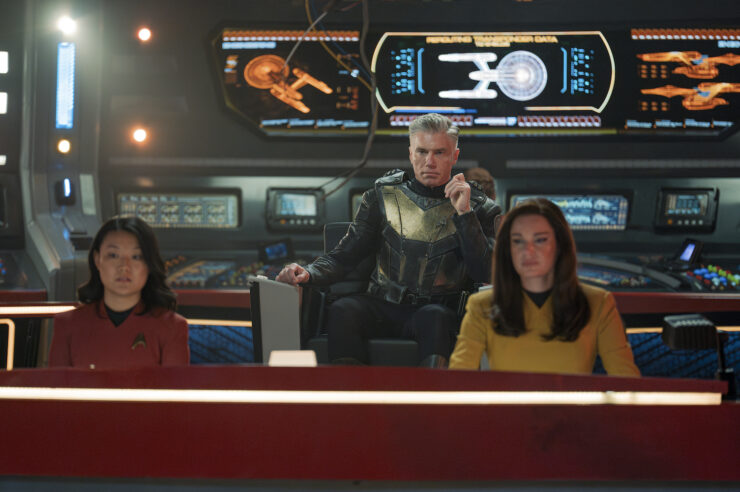
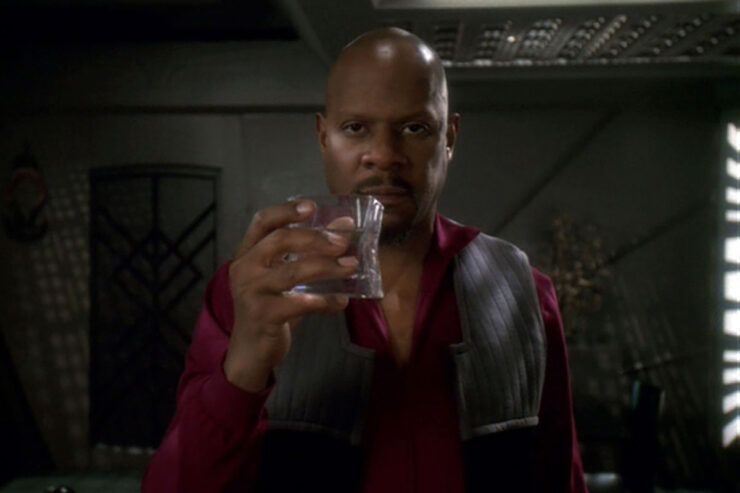
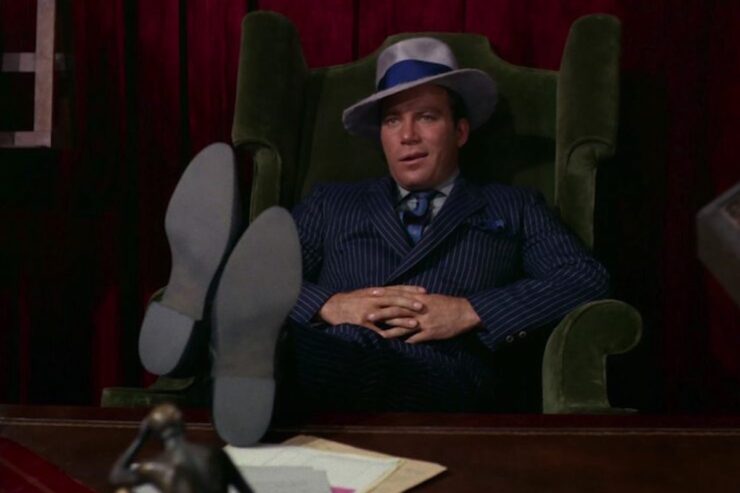
I just hope Greg Cox is still writing a decade from now so he can do a novel reconciling these episodes to reality.
I don’t know. The overly preachy handling of the story (and for me this episode isn’t even as subtle as “Let That Be Your Last Battlefield”) really knocks it down a lot. It was probably made worse by the fact that homelessness was a massive political football at the time and for a lot of people the subject had long passed the point of fatigue.
I also found it difficult to buy San Francisco as the location of a bureaucratically-ignored, dead-end warehouse Sanctuary Zone. A little farther south, what was becoming Silicon Valley, sure, but The City itself? No.
And I would have said the computer Dax is sitting at was quaint even by the standards of the time. It looks like an Apple II. Or a dedicated word processor. Apart from Apple playing a bit with form factors a couple of years after this, the only real changes in the external appearance of desktop units are the complete disappearance of the flat machine in favor of the tower (which was already predominant anyway) and the arrival of flatscreen monitors.
A solid two-parter with a good message. And has some of the feel of Paul Verhoeven’s sci-fi actioners, I thought.
Plus, I want to add what an awesome name “Frank Military” is. That is all.
The one thing that makes this (and its sequel) hard to watch is not the preachyness, although it is a little heavy handed even for Trek… it’s the topicality. We’re not nearly as far as we should be from having a political climate that would support “Sanctuary Districts” as a perfectly legitimate solution to the problem, for example.
I don’t hate this double episode – it’s pretty good, but I find it a bit uncomfortable to watch. This is not all that far-fetched to believe as our reality in a few years. It’s easier though than Homefront and Paradise Lost.
Often with these two-parters the opening episode is strong, while the concluding one fails to live up to the tension established in the first one. This time I think it’s the other way around. This is a perfectly adequate setup but it never really gets your heart racing and, as others have commented, is pretty heavy-handed. But the back half delivers so well that it makes for a very solid collective story.
I think that Brynner was the one to assume that Dax’s spots were tattoos; she just went along with it. When she said “Oh, you mean my tattoos,” he didn’t act as though his confusion had been clarified, but as though they were already on the same page. He went on to say he used to have a Maori tattoo, so it’s natural that he would’ve made that assumption. Dax was smart for immediately catching on to what he was assuming, though.
As for the preachiness, it doesn’t bother me. America treats its homeless so poorly that a heavy-handed critique seems warranted. I’m more bothered by the ease of the time travel, and I’ve never cared for the idea of “chronitons.” (Which, by the way, is an etymological mess. Granted, “chronon” is already taken as the smallest meaningful interval of time in a quantum interaction, but if they had to coin a different term for a quantum of time, it probably should’ve been “chronicon” instead. There’s no inflection or declension of khronos that has an “it” in it as far as I can tell. And there’s no Greek “it” that means anything useful. In DTI: Forgotten History I fudged it as a blend of the Greek for time and the Latin for “go.” But it’s a flimsy rationalization.)
As far as I’m concerned this story earns its preachiness and topicality. I’d include this two-parter in any list of socially relevant Trek episodes. And the longer we go without properly addressing the issue in real life, the more relevant it becomes.
Terry Pratchett fans will be amused by the similarity between this story and his novel Night Watch, which is probably either coincidental or a case of cribbing from the same sources.
DemetriosX: Don’t kid yourself. Things like “Sanctuary Zones” can happen anywhere on Earth.
This episode (speaking of both parts) has always been one of my favorites. Not necessarily for the entertainment value, but for the message. It is a very strong story.
The commentary about what would Humanity do if push came to shove is definitely explored later in the series. I think it is telling to watch this one, “Past Tense,” and then follow up immediately with Season 6 “In the Pale Moonlight.” In the former you have Sisko talking about how its his job as a starfleet officer to make sure they don’t have to find out what they would do in extreme circumstances, and then in the latter you have him complicit in an assasination because the Federation itself was at stake.
This was a great Sliders episode. Kidding! :)
I had a couple hangups, but Avery Brooks’s performance was great to watch.
1. There’s a subtle art to writing a believable dystopia. If you’re veering towards “Escape from New York,” you’re probably on the wrong track. With apologies to our estimable rewatcher, I found more straw than man in the setup.
2. I didn’t really buy the tension either. “Lost in time” is a tricky premise for a show that throws around time travel so casually so often. We’ve accumulated a dozen other tools throughout the continuity to solve this crisis.
That said, there are moments for Avery Brooks to shine. His exhortations for social justice are hints at greater moments to come in the series.
His performance (along with Siddig’s, the guest cast, and some nice comic touches during the search) really redeemed what, for me, came off as a bit of a difficult premise to embrace.
Of course, my fondness for this ep was really sealed by Nog with an aside a few seasons later in “Little Green Men.” ;)
@7: The etymology of “chroniton” is somewhat weird; I never noticed it, though, my mind immediately changed it to “chronoton”, which makes more sense.
And from what I could gather on Memory Alpha, at least the German synchronisation did use the latter term, though not consistently.
@12: I don’t see how “chronoton” would work, etymologically speaking. The suffix used to mean “subatomic particle” is -on, not -ton. So where does the -ot- come from?
As I said, the word should be “chronon,” but that word already means something else. And really, it’s the whole idea of “particles of time” that I find ridiculous. ’90s Trek was too casual about invoking made-up particles as fairy dust for whatever magic they wanted to employ. I preferred it in the early seasons when their advisors actually made an effort to ground things in plausible physics, like “Yesterday’s Enterprise” and its “Kerr loop of superstring material” (which, aside from the misuse of “superstring” to mean “cosmic string,” actually makes a fair amount of sense).
The one problem with “chronon” is that it’s awkward to say. Which is a factor when you’re making up words. :)
—Keith R.A. DeCandido
I’m astonished that anyone is putting so much effort into breaking down the etymological roots of “chroniton.” Out of universe, it’s clearly some technobabble person who came up with it because it sounds science-y and has “chron-” in it which most of the audience would recognize as having something to do with “time.”
In universe, I have no reason to think it’s any different. Some science guy at Starfleet said, “I’ve found a new particle, I need a name.” Someone else said “What about ‘chroniton’? That sounds vaguely time-ish.” The first guy said, “Fine, whatever.” I guarantee nobody anywhere was worried about Greek or Latin roots and declensions.
Having now taken three paragraphs to say “It doesn’t matter, nobody cares,” I’ll move on.
I am also depressingly able to believe that San Francisco was a likely candidate for sanctuary districts, especially in the city. I lived in Haight for about 9 months, and the city has a big homeless problem, and a big ‘don’t give a shit’ problem to go with it.
I normally am a bit skeptical about the time travel episodes, but I did find this one really well done (along with its second parter) as well as sadly relevant. Even though I predicted a few things (was pretty sure Bell was going to bite it as soon as they mentioned his name)…most of it did keep me on the edge of my seat wondering how it was going to be resolved.
I also think that the extra syllable in chroniton is for easy speakability.
This episode is not heavy handed at all.
That is frankly how life is becoming for a wide part of our population, here in Europe. In Spain, 5.9 million people are unemployed – the country only has a population of 46 million. In the UK, the rhetoric levelled against the unemployed is unbearable – workfare is being introduced, and one could imagine the return of the workhouse. As the working classes are demonised more and more, they are also forced, by economic neccecity, to congregate in ghettos.
The unemployment itself is probably ‘technological unemployment’, i.e. entirely natural within the system we have and choose. As information technology, robotics and other fields with very low labour intensity replace labour-intense industries, more and more of the population becomes surplus. But they are still blamed for not finding work, and treated to ever more stringent rules in order to recieve welfare.
It’s incredible how prescient this episode was.
@13: -t- is, as far as I can tell, a fairly common change from -s when a suffix is appended to a word in ancient latin and greek, and as noted, the term “chronon” is already in use as a term for a quantum of time (also, I was under the impression that “chronitons” were “particles related to time effects”, not simply time quantums), so a different term seems warranted.
Also, keep in mind that most particle names don’t make complete sense etymologically speaking – just look at “neutrons” and “positrons”.
@18: But then, as mentioned above, it should be “chronoton,” not “chroniton.” There is a khronos form, but not a khronis form as far as I’m aware.
As for “neutron” and “positron,” at least it’s easy to see where their parts came from. The “-tron” suffix is a back-formation from “electron,” which is from the Greek word for amber (since amber has a static charge when rubbed, so electricity was named after it). The prefixes come from “neutral” and “positive” in turn. So every letter is accounted for. But that “-it-” in “chroniton” is just random. It comes from nowhere. Constructing a word from fragments of Greek and Latin roots has abundant precedent, but just pulling letters out of a hat is a different matter.
Fahrbot: Not just in España. In Italia, in Hellas and Portugal, in the United Kingdom it’s been creeping in, and in Canada…
“Prescient” doesn’t begin to cover that episode, I fear.
To para
timephrase H Beam Piper: The English language is the result of Norman men at arms trying to get in bed with Saxon barmaids. Any Latin or Greek words that fall into that mess will just have to look out for themsleves.There were two small nitpicky problems with the episode for me. The first problem was that everyone’s clothing in the Sactuary didn’t look distressed enough. It appeared as though everyone just walked out of a JC Penney’s ad.
The second problem was the farfetched (to me) technobabble explanation about why the Defiant survived the timeline shift. If the writers were going to crib from the storyline of The City On The Edge of Forever, they should have went whole hog and had the Defiant disappear, and only reappear once Sisko ‘fixed’ the timeline by reenacting the events of the Bell Riots. I guess I’m suffering from technobabble fatigue after watching so much Trek lately. Usually I’m somewhat on board with O’Brien but this time around, not so much.
@22: Yeah, but disappear from whose viewpoint? Without someone being protected from the timeline shift and able to observe the change, there’d be no way for the audience to know the timeline was in jeopardy at all.
Although they could’ve gone the “Yesterday’s Enterprise” route and shown the altered 24th century; but that would’ve been a whole other story and might’ve made things too cluttered and too expensive.
I think what always annoys me about these time-travel episodes in ST, is the idea that even though they’ve messed up the timeline they can somehow fix it and it will be exactly what it was
beforewithout their interference. (Another annoying bit is how hard it is to write coherently about time travel episodes – words like “before” start to make no sense.) Anyone who has studied chaotic systems knows that complex systems can become extremely sensitive to initital conditions. You know, the butterfly effect. There’s no way Sisko can do everything that Bell did, in exactly the right way to get the same effects as the real Bell, while also cancelling out the effects of the disruptions that he, Bashir, and Dax are causing. Perhaps I’m overthinking it. In any case, when you add in the heavy handed preaching this episode wasn’t one I would consider among my favorites.This 2 parter bored me to within an inch of my life. I didn’t have much to do while I waited for the episode to finally go somewhere, so I kept watching for that prominent guy Sisko had mentioned to finally show up. Then I kind of played with the idea that something would happen to that guy, and since Sisko was el experto on him and his role in the past, he would end up assuming his role. When the guy finally did show up, was black, and got killed within about 5 seconds, not only did it confirm my theory, but I practically did a spitake on my computer screen.
And of course we get the standard DS9 ridiculous time travel explanation: crap on the hull messed with the transporter to send them back in time, right in time for a major event in history naturally. And I don’t understand why the Federation would’ve vanished from the Defiant’s viewpoint. Past guy died, and Sisko assumed his role. Whatever change that would’ve transpired from past guy dying was course corrected after Sisko assumed the role. As I recall, there wasn’t ever any contact between the Defiant and past people over the course of the 2 parter, so it’s not like their involvement helped correct the course of events. As far as they were concerned, everything happened in the past, so nothing they saw should’ve been effected.
I have no problem with the technology being different on the show than it is for us today for the simple reason that Star Trek does not exist in our timeline. The timeline set down (largely by the Original Series) is different than what we’ve experienced- the lack of DY-100 Sleeper ships doing interplanetary journeys for example, the 1993 Eugenics War, and the Bell Riots are only two years before World War III in 2026. (thank you Memory Alpha for keeping all of this straight for me)
Now I realize that a lot of that is inconsistent with each other (technology differences, the fact that space exploration milestones achieved in Voyager seem unlikely in the midst of a 25 year world war seen in TOS and ENT) but bottom line, the timeline of Star Trek is much different than our own.
This episode does do an excellent job of pointing out that in order to be an enlightened state, the Federation (and more specifically earth) had to have had some seriously dark periods in its history. One thing I did have issue with is the consistency of the accidental away team- Sisko knows everything, Bashir is completely clueless (mostly so Sisko can lecture to someone) and Dax is beautiful and fits right in. It would have been interesting if there was someone who could have at least had a different perspective than Sisko did- somene who could have said “Yes, but…” I agree with Sisko that the extreme case of creating a ghetto and throwing all of the homeless in it is a pretty vile practice (to quote Kirk- “Earth Hitler 1938”) but it’s a bit of a strawman exercise. We are left with the impression that the government at the time is either pretty much given up the idea of individual liberty – I find it hard to believe that the California Courts system would allow a sanctuary district- or that the economic conditions in the dystopian future/past are pretty bleak. It would have been good to have some fleshing out of that point of view.
Avery Brooks is amazing in his passion and probably brings more of himself to the Trek Universe than any other actor. Brooks himself has said that it was important to portray himself as a positive black father on TV and his strong views on racial equality have always shined through (as Benny in “Far Beyond the Stars” and when talking about Las Vegas 1962), and it is truly awesome to see how he throws himself into the role, but in this case the historical background could have helped.
@26: It’s not a straw man. It’s sadly not that much of an extrapolation from the way the homeless were treated at the time and are still treated today in many places. See comment #17.
Fahrbot: its even worse than you think in the UK now-the handicapped are being subject to abuse because of the widespread belief that they`re scamming the system by getting any aid from it (`benefit scrouging`):
Life in a wheelchair: ‘Why do you walk funny?’
Disability hate crime: is ‘benefit scrounger’ abuse to blame?
By the way, Utah is already more than 3/4 of the way to solving its homelessness problem — by just giving them homes.
http://www.nationofchange.org/utah-ending-homelessness-giving-people-homes-1390056183
Turns out that just giving away apartments to homeless people (along with case workers to guide them toward self-sufficiency) costs the state less per year than the costs of medical treatment and incarceration for people forced to stay homeless. And this is a red state that figured this out. Although the article points out that there are many other places around the country where government policies toward the homeless are increasingly heading in the direction of the Sanctuary Districts or worse.
Just curious, are you familiar with the tiny homes proposal? In Wisconsin, they are starting a ‘tiny house community’ to help combat homelessness. There was some controversy though because of fears that it would become basically a shantytown, that the homes wouldn’t be good, etc. In some ways the criticism comes from both sides; people that are worried that the homes will be sub-standard/unsafe, and that a few small homes isn’t really going to solve a systemic problem, and then people that basically just don’t want a bunch of homeless people congregating and ‘causing trouble’.
I am not sure how I feel about it – I actually love the tiny house movement in general and if I wasn’t married/had children, I would seriously consider it. So I don’t feel that a tiny house is necessarily bad housing, if done right. It seems like at least somebody is trying to do SOMETHING that’s better than just sleeping in a car or under a bridge. But I can definitely see how it could end up being abused anad basically end up like a place to shove homeless people and then not think about it.
http://host.madison.com/ct/news/local/writers/pat_schneider/madison-city-council-unanimously-approves-tiny-houses-village-for-east/article_26051bdc-d5e5-11e3-a2c6-0019bb2963f4.html
By the way, that article (the one CLB posted) was really interesting, and I’m also happy to see that charitable/religious groups aren’t backing down in the face of some of these ordinances.
As anvilicious as Bashir’s speech about the Federation possibly not sticking to its ideals are, it does foreshadow developments we later see in the series, notably in episodes like the Earth two-parter in season four, “Inquisition”, and “In the Pale Moonlight”. I appreciate it a little for that.
You know, I lived in san Francisco for about 10 years and the sanctuaries weren’t far off then. I lived in a neighborhood called the Tenderloin (or the TL as we so liked to call it) It was crammed full of the city’s poor, mentally challenged, and homeless. The rest of the city was booming. We stood in food lines, shopped for clothes in donation boxes and did what we could to survive. The scene with Bashir and Sisco waiting in line for assistance that would never really materialize really rang true because I have been there. There are many types of walls, only a few of them are actually made of stone. I was lucky enough to get out. I was employable. I moved out of SF and to Idaho where I could get work, a home and a family. I was one of the lucky ones. From what I hear even the poorer neighborhoods are being encroached upon by wealth landlords turning the neighborhood into condos that only the ultra wealthy can afford. The poor are simply shipped away to who knows where. This episode was no a stretch by any means.
Just re-watched this episode. I live in San Francisco. One-bedroom apartments in my neighborhood are now renting for over $3500 a month. (My partner and I were lucky to get a rent-controlled unit over 12 years ago for much less.) And this is just up the hill from the Tenderloin district the previous commenter mentioned. We have a lot of homeless people and a lot of long-time tenants being evicted from their homes, and I could definitely see the events of this episode unfolding in our future.
I really love this episode, both parts. I really enjoy learning more about the “past” of the ST universe, and I didn’t find this first part too heavy handed or preachy. I do agree that it seems like Bashir’s comments about the Federation not compromising its principles or somesuch are setting up future storylines like “Siege of AR…”, ” Pale Moonlight”, and the Section 31 stuff.
@33: I could see something like this happening under Donald Trump with illegal immigrants. They would be placed in “Welcome Centers” near the Mexican border and told they would be welcomed back to Mexico. Problem is, if Mexico doesn’t have the resources or infrastructure to take back over 10 million people, you might see a lot of them living in squalid camps over the border. It would be one of the most serious humanitarian crises of the 21st century
Hi, all–we understand the urge to explore real-world parallels here, particularly with this episode, but we’d also like to avoid getting too deep into speculation involving the possible results of the current election. In the interest of keeping the conversation civil and on-topic, further thoughts on the current state of U.S. politics is a topic better explored elsewhere.
I apologize. I was merely continuing the conversation that some people said they could picture something like this happening in real life.
Is this the first Star Trek story where people time-travel into a past that’s still our future? At least it precedes First Contact.
Anyway, I really liked it – everything from Dax’ quick-wittedness and technical expertise to Sisko and Bashir’s struggles and the portrayal of 21st century people and society. I agree with comment #25 that there shouldn’t have been any changes to the 24th century because this is not like The City on the Edge of Forever, where first one person travels to the past and changes history and then others follow to undo the change; but since all the rest was so good it didn’t bother me.
@39/Jana: Well, TOS: “Tomorrow Is Yesterday” was supposed to be set in the near future at the time, since “the first manned moon shot” was still a couple of years away. Otherwise, yes.
@40/Christopher: Thank you! That means it really is this episode that introduces the idea of visiting one of Star Trek’s not-so-nice near-future societies. Cool.
There haven’t been any comments on this episode since the 2016 election, so let me be the first to say that it’s no longer difficult at all to imagine this future actually arising in the next…wow, only seven years. In fact, it’s almost likely, given the wealth disparity, tolerance for racism and rise in fascism. If anything, the society depicted in the episode is probably much more civil (no drug abuse shown, for instance, and the security forces are overworked but not overtly brutal) than what the future will likely be. And that’s the world our kids will inherit.
@41/Jana: Belated reply here, but I’d say the first Trek episode that “visited” one of those not-so-nice near-future periods was “Encounter at Farpoint,” where Q put the crew on trial in what was either a recreation of the “Post-Atomic Horror” of 2079 (a “very, very accurate” one, according to Data) or actual time travel back to it (I assume the former, but it was never entirely clear).
After having rewatched this episode, I was a bit disappointed to realise it features one of my least favourite tropes in American mainstream fiction, the idea that “the United States is the whole world”. (Admittedly this is a very common trope in most TV series produced in the US, but I keep on hoping Star Trek would be enlightened enough to avoid it.) When Sisko & Bashir change a crucial moment in American history, the folks aboard the Defiant can’t find any subspace signals in the entire solar system. So changing history so that the US doesn’t start taking better care of its homeless and disenfranchised doesn’t just mean that Earth won’t become a part of the Federation, it means that subspace technology (and by implication, space travel) doesn’t exist there at all in the 24th century!
Ok, we know that Zephram Cochrane was American, but inventions like the warp drive are rarely something that happen only because one individual genius came up with them. Since they’re based on the laws of physics, most crucial inventions like that have typically been thought of by several people around the world, and the “father”/”mother” of the invention just happens to be the one among them who first but these ideas into practice. But here we’re expected to believe that because the United State went into shambles, no one in the rest of the world came up with the idea of the warp drive in 300 years?
Given that the economic situation of the US is shown to be pretty bad in 2024 (worse than it’s likely to be in the real world in 7 years), and knowing what we know about the state of the world, it would make much more sense if Sisko and Bashir altering the past would create an alternate where China was the leading country of the world, the warp drive was invented there, and by the 24th century Federation headquarters were located in Beijing. Though I guess it’s possible to assume that in the Trek timeline something really bad happened to China; this would explain why in the various series all the Eastern Asian character we meet are either Japanese (Hikaru Sulu, Keiko O’Brien, Hoshi Sato) or Korean (Harry Kim), even though statistics alone would suggest there should be more people of Chinese origin in Starfleet. But even if China is out of the picture, it’s pretty ridiculous to assume that no other nation than it or the US made any advances in warp & subspace technology and space travel in three centuries.
Yeah, that US-is-the-end-all-of-Earth is something you just have to take in stride when you’re from another country and watch US TV shows, like you (I assume) and I. :)
@44/Tuomas: Maybe if the US never confronted the problems with the Sanctuary Districts, it meant that American culture continued to become less humane and more cruel, and that led to America taking a more aggressive stance in WWIII, resulting in an escalation that effectively wiped out civilization. (This is easy to imagine in the context of current events.) And without Cochrane’s warp flight, Vulcan never intervened to help humanity rebuild. And with no starfaring Earth, the Romulans ended up conquering Vulcan and other local powers.
It is easy to imagine that, but the thing is it’s that in US shows it’s almost always like this. I understand why, and I tolerate it, but we can say that we disagree with it always being like this.
@47: Oh, certainly — it is unfortunate that the bias exists. But I can understand why they did it in this case, at least. They were telling a story that was meant as an allegorical commentary on what was going on in America at the time (and still today, unfortunately), and they were using the future setting to serve that more America-directed message. So saying “Well, all that changed is that China invented warp drive instead,” however plausible it is in the abstract, wouldn’t have served the needs of the specific allegorical statement they were making.
So the goal wasn’t specifically to say “As America goes, so goes humanity,” although that is the unintended implication. It was more to get American audiences to think about a problem in their own culture and society, to symbolically convey the idea “We can’t achieve a better future if we don’t improve the way we treat each other today.”
@47 and @48 The other issue is that Sisko and Co. needed a reason why the universe was so awful that they had to restore the timeline. The counter narrative, that the Chinese invented warp drive, went into space and became an evil empire has its own problems, probably ones that would be even more offensive and harder to hand wave. That type of thinking led to TOS’s Omega Glory and one Omega Glory in a franchise is plenty!
And of course, the real message was to challenge prejudice by showing that the entire future of humanity could hinge on the actions of one homeless black man.
I don’t need to have the specific reasons for this iteration of the trope, I understand them. It’s the endless repetition of it (as US fiction is watched/read around the world) that sometimes causes people from other places, like me, to say “well, every once in a while it could be about some other country”, particularly today, when they know their shows are sold around the world.
I rewatched this last night. We’re only six years away from 2024. As far as real-world events are concerned, I think it’s safe to say that the government’s establishment of concentration camps for immigrants (while segregating families in the containment process) is as close to having a real functioning Sanctuary District as it gets. This is one future prediction Trek nailed. Way too accurate and close for comfort. If anything, this episode plays even better now.
The difference is we still have outraged people protesting. I hope they don’t lose their drive to fight this.
Eduardo: Indeed. Heavy sigh.
—Keith R.A. DeCandido
@52 Having just rewatched this one I had similar thoughts. It makes for an interesting exercise reading the review and most of the comments knowing what we know about the incoming orange menace in just 3 short years on from that date. What this administration has already done makes me feel like the writers just lacked the inherent cruelty to think up something of comparable inhumanity.
One thing I wanted to point out and was surprised nobody caught it (not that it matters really)…
Do you mean the guy writing on Sisko’s leg because that sure doesn’t look like Bell to me.
It’s 2019 now (happy new year) and I don’t have much to add, but this two-parter scared the bejesus out of me. I was sweating and shivering as I watched this — and only partly because I have strep throat — because it’s too realistic in many ways.
KRAD, you gave it a 7 (but I know you say the score is the least important part of the rewatch); in light of current events, I personally give this a 10 and it’s on my list of episodes I recommend everyone watch or rewatch. It’s just so relevant, and I can only hope it doesn’t become more relevant by 2024.
And really, this is just some excellent commentary from DS9, in a manner that TNG just couldn’t have tackled. The state of society on Earth in First Contact, for example, was cheesey and unbelievable in my opinion, but it fit TNG’s tone.
Avery Brooks is an incredible actor. I didn’t really appreciate that until Crossover, where he made me believe he was a completely different person, and this is another incredible performance from him.
I have to be honest, I really didn’t mind the long expository conversations between Sisko and Bashir. I thought they were well written, well acted and appropriately depressing.
I came to reread this, and hope to rewatch the episodes this week, because dang it, they’re still far too relevant.
Four more years*!
Until… I guess we’ll see.
*Give or take a few days; just turns out my DS9 pandemic rewatch ended up here today.
I think we all have to check in with this two parter every year to make sure we’re not matching this future too closely.
Well, it’s now 3 years away, and this episode feels more prescient than ever, considering the present situation. It’s starting to feel a little uncanny, to be honest.
While this episode was gripping, the opening log entry totally distracted me: Sisko’s sister lives in Portland? Which Portland, Oregon or Maine? And why did the writers say Portland and not somewhere bigger and more specific, like Seattle? Or less specific, like ‘back home’? Anyway, this two-parter, as many have said, continues to feel relevant, especially here in Portland OR with lengthy protests and riots, simply massive homelessness, and ever-changing Covid restrictions. I was envious of Our Heroes because they know there’s a great big beautiful tomorrow waiting for them, at least on the primary federation planets.
Happy (?) 2024…
One dated example not yet mentioned of the creative team’s lack of imagination and/or, if you prefer, an in-story case point of dystopia is all the signage being set in Apple’s f—ing Chicago typeface.
I don’t think it was Bell scribbling on Sisko’s leg either.
Happy Past Tense Day! Let the Bell Riots begin!